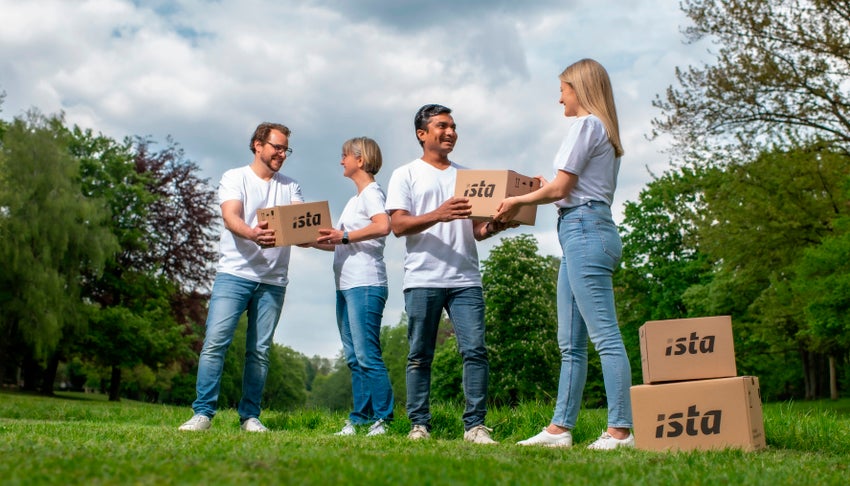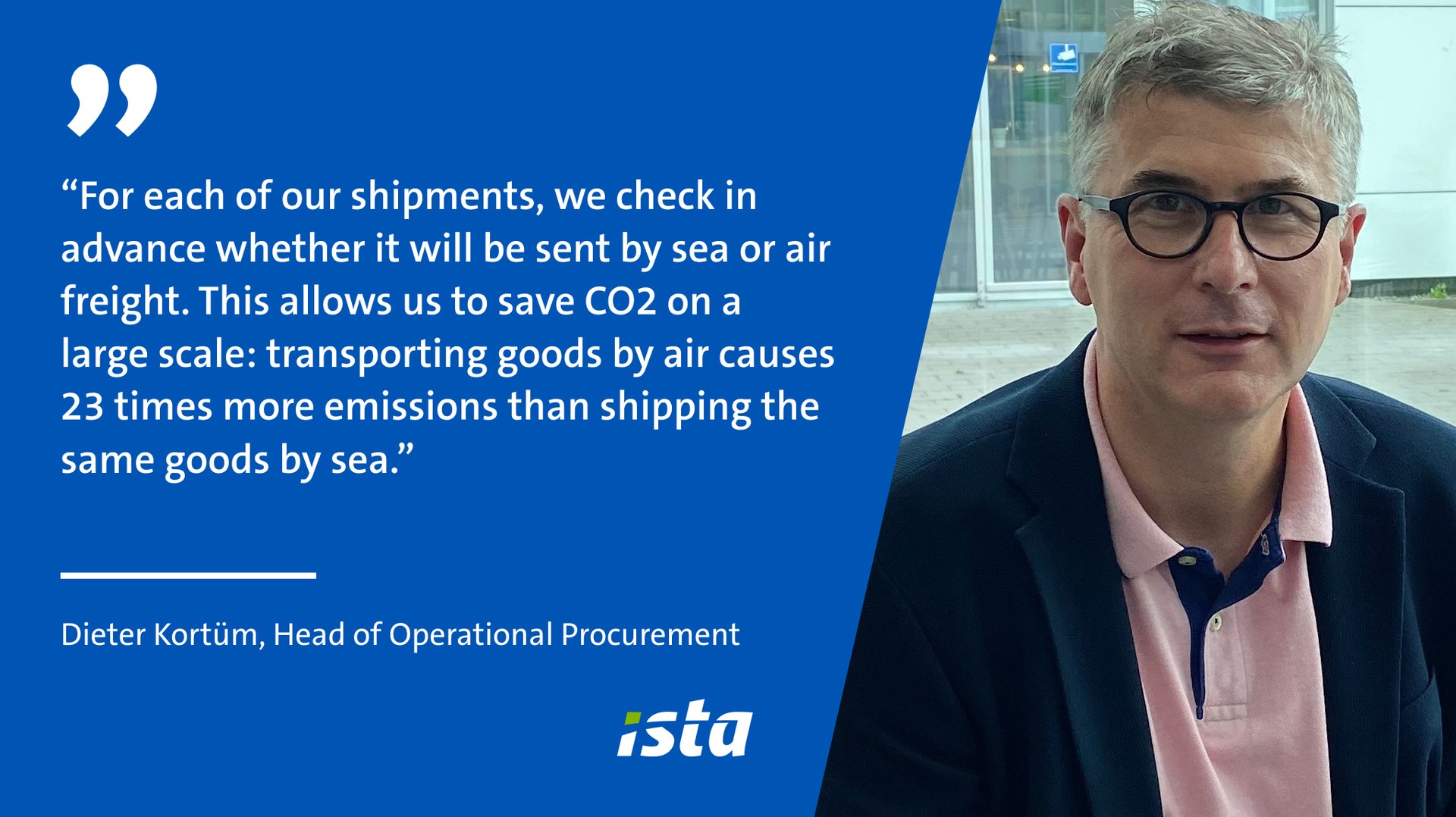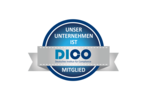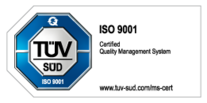
- Internet Corporate
- Contact & Service
- ista Blog
- All for Zero! Why ista is zero alone on climate protection

In global supply chains, many partners share responsibility for sustainable action. ista’s progress report explains how resources are conserved and emissions reduced in the process.
Dieter Kortüm is in charge of Operational Procurement at ista and knows exactly what is important to ensure goods are available and, at the same time, reduce CO2 emissions.
“For each of our shipments, we check in advance whether it will be sent by sea or air freight,” Dieter Kortüm explains. “This allows us to save CO2 on a large scale: transporting goods by air causes 23 times more emissions than shipping the same goods by sea.” A strong argument for the sea route as ista has set itself ambitious targets to reduce its own carbon footprint.
The company has already been operating climate-neutral since 1 July 2021; ista intends to be CO2-free by 2030. Together with its partners, ista is therefore implementing a variety of measures that are particularly effective with regard to the net-zero target – in line with the motto of ista’s newly published progress report: “All for Zero!”

Ensuring availability and reducing emissions
Together with his colleagues from the Procurement & Supply Chain department, Dieter Kortüm works to minimise CO2 emissions in the supply chain while ensuring uninterrupted supply. To do this, he has to assess on a case-by-case basis whether the goods will arrive on time by ship. By sea, for example, selected devices and preliminary products that ista has had manufactured in Asia take seven to eight weeks to reach their destination in Germany. By air freight, it would take one to two weeks, says Kortüm, at a much higher price, of course. So there are many factors that have to be considered if he is to make the right decision every time.
“Our top priority is, of course, availability,” Kortüm emphasises. “If the goods will arrive by sea freight with enough time to meet all requirements, we choose this route." Another way of reducing CO2 emissions: whenever possible, we at ista bundle freight consignments together so we can cut emissions and costs even on the last leg to the final destination, Kortüm explains: “With a fully loaded lorry, we need fewer journeys, and the truck also does not need to make any stops at reloading points and heads straight for its destination.”
Disruptions in global supply chains
How sensitive international supply chains are to disruptions is something Dieter Kortüm experiences again and again in his work. When in March 2021 a container ship ran aground in the Suez Canal, ships were not able to pass in either direction for many days. “That was of course a very tense time,” Kortüm recalls. “Goods from ista were also affected. For us, the first question was: how long will this take? Do we have to have the next consignment sent by air freight? Or should we go via South Africa, which takes two weeks longer?”
The spring of 2022 also sees global trade out of sync. The Covid-19 lockdown in Shanghai and the war in Ukraine are causing disruption to supply chains. In the North Sea, there are queues of cargo ships that cannot be unloaded on schedule in the Port of Hamburg because capacities there are stretched to the limit. “Such problems can only be solved by good teamwork,” says Dieter Kortüm. “If things come to a standstill somewhere, you have to work together with the suppliers, the forwarders, with your own logistics team to make sure the goods are in the right place at the right time.”
Conserving resources through recycling
In future, ista wants to make itself less dependent on air and sea freight, for example by designing next-generation devices from the outset so that their manufacture requires less assembly by hand, Kortüm explains. They could then also be produced cost-effectively in Europe, thus dispensing with many emission-intensive consignments by ship or plane. Recyclability will also be given greater consideration in the future, even at the design stage: “We want to move away from disposable products,” says Dieter Kortüm. “If devices are easier to dismantle, components and raw materials can be recycled more easily.”
This is already happening to an ever-greater extent at ista: used devices, such as the gateway, are recycled so that fewer new ones have to be produced. Data concentrators were also recycled for the first time last year: just under 14,000 units by the start of May 2022. In addition, 105 tonnes of brass from components of the sensonic II heat meter were melted down and recycled. The brass housings of the ista water meters are also to be recycled from 2022.
YouTube aktivieren
Wenn Sie Youtube aktivieren, gelten die Datenschutzbestimmungen von YouTube.
1) Um die Youtube Einbindung zu aktivieren, klicken Sie bitte auf "Consent Banner öffnen".
2) Setzen sie bitte ihr Häkchen in die Box neben □ YouTube Video. Sollten Sie YouTube Video nicht direkt im Pop-Up Banner sehen, navigieren Sie bitte dorthin.
3) Klicken Sie zum Abschluss auf den blauen Button "Speichern und Schließen"
Working together on a sustainable future
ista also expects its partners and suppliers to have ambitious sustainability targets. “We conclude appropriate agreements with our key suppliers,” Kortüm explains. Clear sustainability goals are a must when we select future suppliers and logistics partners: “When we compare offers, such environmental aspects already come into play much more than they used to years ago.”
Dieter Kortüm has been working at ista since 1993. After training as an industrial clerk, he first spent four years in the furniture industry before moving to ista. The fact that working on a sustainable future is part of his job profile at ista is something the 56-year-old very much appreciates. “I have three children and they should live in a world that is at least as good as when I was born,” he says, “and I am glad that we at ista are doing our bit by avoiding emissions and encouraging people with our products and services to act in a climate-friendly way. We only have this one world and we have to take good care of it.”






